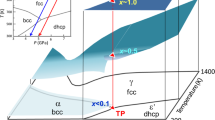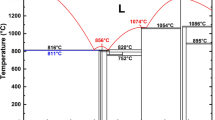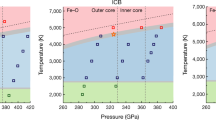Abstract
The Earth’s solid core is mostly composed of iron. However, despite being central to our understanding of core properties, the stable phase of iron under inner-core conditions remains uncertain. The two leading candidates are hexagonal close-packed and body-centred cubic (bcc) crystal structures, but the dynamic and thermodynamic stability of bcc iron under inner-core conditions has been challenged. Here we demonstrate the stability of the bcc phase of iron under conditions consistent with the centre of the core using ab initio molecular dynamics simulations. We find that the bcc phase is stabilized at high temperatures by a diffusion mechanism that arises due to the dynamical instability of the phase at lower temperatures. On the basis of our simulations, we reinterpret experimental data as support for the stability of bcc iron under inner-core conditions. We suggest that the diffusion of iron atoms in solid state may explain both the anisotropy and the low shear modulus of the inner core.
This is a preview of subscription content, access via your institution
Access options
Access Nature and 54 other Nature Portfolio journals
Get Nature+, our best-value online-access subscription
$29.99 / 30 days
cancel any time
Subscribe to this journal
Receive 12 print issues and online access
$259.00 per year
only $21.58 per issue
Buy this article
- Purchase on Springer Link
- Instant access to full article PDF
Prices may be subject to local taxes which are calculated during checkout




Similar content being viewed by others
References
Birch, F. Elasticity and constitution of the Earth’s interior. J. Geophys. Res. 57, 227–286 (1952).
Dziewonski, A. M. & Anderson, D. L. Preliminary reference Earth model. Phys. Earth Planet. Inter. 25, 297–356 (1981).
Brown, J. M. & McQueen, R. G. Phase transitions, Grüneisen parameter, and elasticity for shocked iron between 77 GPa and 400 GPa. J. Geophys. Res. 91, 7480–7494 (1986).
Nguyen, J. H. & Holmes, N. C. Melting of iron at the physical conditions of the Earth’s core. Nature 427, 339–342 (2004).
Anzellini, S., Dewaele, A., Mezouar, M., Loubeyre, P. & Morard, G. Melting of iron at Earth’s inner core boundary based on fast X-ray diffraction. Science 340, 464–466 (2013).
Boehler, R. Temperatures in the Earth’s core from melting-point measurements of iron at high-static pressures. Nature 363, 534–536 (1993).
Belonoshko, A. B. & Ahuja, R. Embedded-atom molecular dynamic study of iron melting. Phys. Earth Planet. Inter. 102, 171–190 (1997).
Alfé, D., Gillan, M. J. & Price, G. D. The melting curve of iron at the pressures of the Earth’s core from ab initio calculations. Nature 401, 462–464 (1999).
Belonoshko, A. B., Ahuja, R. & Johansson, B. Quasi-ab initio molecular dynamic study of Fe melting. Phys. Rev. Lett. 84, 3638–3641 (2000).
Belonoshko, A. B. et al. Origin of the low rigidity of the Earth’s inner core. Science 316, 1603–1605 (2007).
Belonoshko, A. B., Skorodumova, N. V., Rosengren, A. & Johansson, B. Elastic anisotropy of the Earth’s inner core. Science 319, 797–799 (2008).
Mattesini, M. et al. Hemispheric anisotropic patterns of the Earth’s inner core. PNAS 107, 9507–9512 (2010).
Hemley, R. J. & Mao, H.-K. In situ studies of iron under pressure: new windows on the Earth’s core. Int. Geol. Rev. 43, 1–30 (2001).
Mikhaylushkin, A. S. et al. Pure iron compressed and heated to extreme conditions. Phys. Rev. Lett. 99, 165505 (2007).
Belonoshko, A. B. et al. Quenching of bcc-Fe from high to room temperature at high-pressure conditions: a molecular dynamics simulation. New J. Phys. 11, 093039 (2009).
Nguyen, J. H. et al. Molybdenum sound velocity and shear modulus softening under shock compression. Phys. Rev. B 89, 174109 (2014).
Hixson, R. S., Boness, D. A., Shaner, J. W. & Moriarty, J. A. Acoustic velocities and phase transitions in molybdenum under strong shock wave compression. Phys. Rev. Lett. 62, 637–640 (1989).
Lukinov, T., Simak, S. I. & Belonoshko, A. B. Sound velocity in shock compressed molybdenum obtained by ab initio molecular dynamics. Phys. Rev. B 92, 060101(R) (2015).
Tateno, S., Hirose, K., Ohishi, Y. & Tatsumi, Y. The structure of iron in Earth’s inner core. Science 330, 359–362 (2010).
Dubrovinsky, L., Dubrovinskaia, N. & Prakapenka, V. Is iron at the Earth’s core conditions hcp-structured? Fisica de la Terra 23, 73–82 (2011).
Belonoshko, A. B., Ahuja, R. & Johansson, B. Stability of the body-centered-cubic phase of iron in the Earth’s inner core. Nature 424, 1032–1034 (2003).
Vocadlo, L., Alfé, D. & Price, G. D. Possible thermal and chemical stabilization of body-centered-cubic iron in the Earth’s core. Nature 424, 536–539 (2003).
Ross, M., Young, D. A. & Grover, R. Theory of the iron phase diagram at earth core conditions. J. Geophys. Res. 95, 21713–21716 (1990).
Godwal, B. K., Gonzales-Cataldo, F., Verma, A. K., Stixrude, L. & Jeanloz, R. Stability of iron crystal structures at 0.3–1.5 TPa. Earth Planet. Sci. Lett. 409, 299–306 (2015).
Nishitani, S. R., Kawabe, H. & Aoki, M. First-principles calculations on bcc-hcp transition of titanium. Mater. Sci. Eng. A312, 77–83 (2001).
Petry, W. et al. Phonon dispersion of the bcc phase of group-IV metals. I. bcc titanium. Phys. Rev. B 43, 10933–10947 (1991).
Petry, W. et al. Phonon dispersion of the bcc phase of group-IV metals. II. bcc zirconium, a model case of dynamical precursors of martensitic transitions. Phys. Rev. B 43, 10948–10961 (1991).
Niu, Z. W., Zeng, Z. Y., Cai, L. C. & Chen, X. R. Study of the thermodynamic stability of iron at inner core from first-principles theory combined with lattice dynamics. Phys. Earth Planet. Inter. 248, 12–19 (2015).
Souvatzis, P., Eriksson, O., Katsnelson, M. I. & Rudin, S. P. The self-consistent ab initio lattice dynamical method. Comp. Mater. Sci. 44, 888–894 (2009).
Deguen, R. Structure and dynamics of Earth’s inner core. Earth Planet. Sci. Lett. 333–334, 211–225 (2012).
Romanowicz, B. et al. Seismic anisotropy in the Earth’s innermost inner core: testing structural models against mineral physics predictions. Geophys. Res. Lett. 43, 93–100 (2016).
Ping, Y. et al. Solid iron compressed up to 560 GPa. Phys. Rev. Lett. 111, 065501 (2013).
Blöchl, P. E. Projector augmented-wave method. Phys. Rev. B 50, 17953–17979 (1994).
Kresse, G. & Joubert, D. From ultrasoft pseudopotentials to the projector augmented-wave method. Phys. Rev. B 59, 1758–1775 (1999).
Kresse, G. & Hafner, J. Ab-initio molecular-dynamics for open-shell transition-metals. Phys. Rev. B 48, 13115–13118 (1993).
Kresse, G. & Furthmüller, J. Efficiency of ab-initio total energy calculations for metals and semiconductors using a plane-wave basis set. Comput. Mater. Sci. 6, 15–50 (1996).
Wang, Y. & Perdew, J. P. Correlation hole of the spin-polarized electron-gas, with exact small-wave-vector and high-density scaling. Phys. Rev. B 44, 13298–13307 (1991).
Perdew, J. P. et al. Atoms, molecules, solids, and surfaces- applications of the generalized gradient approximation for exchange and correlation. Phys. Rev. B 46, 6671–6687 (1992).
Mermin, N. D. Thermal properties of the inhomogeneous electron gas. Phys. Rev. 137, A1441 (1965).
Sutton, A. P. & Chen, J. Long-range Finnis–Sinclair potentials. Phil. Mag. Lett. 61, 139–146 (1990).
González, D. & Davis, S. Fitting of interatomic potentials without forces: A parallel particle swarm optimization algorithm. Comput. Phys. Commun. 185, 3090–3093 (2014).
Acknowledgements
Computations were performed using the facilities provided by the Swedish National Infrastructure for Computing (SNIC) at the National Supercomputing Center in Linköping (Sweden). We also wish to thank the Swedish Research Council (VR) for financial support (grants 2013-5767 and 2014-4750). A.B.B., J.Z. and J.F. acknowledge funding from the National Magnetic Confinement Fusion Program of China (2015GB118000) and the China Scholarship Council. S.I.S. acknowledges Linköping Linnaeus Initiative for Novel Functional Materials (LiLi-NFM) and the Swedish Government Strategic Research Area in Materials Science on Functional Materials at Linköping University (Faculty Grant SFO-Mat-LiU No. 2009 00971).
Author information
Authors and Affiliations
Contributions
A.B.B. designed the study, performed calculations and wrote the paper; T.L. performed calculations and wrote the paper; J.F. and S.D. performed calculations and discussed the paper; J.Z. discussed the paper; S.I.S. performed the calculations and wrote the paper; all authors discussed the results and contributed to paper writing.
Corresponding author
Ethics declarations
Competing interests
The authors declare no competing financial interests.
Supplementary information
Supplementary Information
Supplementary Information (PDF 797 kb)
Supplementary Information
Supplementary Information (MP4 19457 kb)
Rights and permissions
About this article
Cite this article
Belonoshko, A., Lukinov, T., Fu, J. et al. Stabilization of body-centred cubic iron under inner-core conditions. Nature Geosci 10, 312–316 (2017). https://doi.org/10.1038/ngeo2892
Received:
Accepted:
Published:
Issue Date:
DOI: https://doi.org/10.1038/ngeo2892
This article is cited by
-
Imaging the top of the Earth’s inner core: a present-day flow model
Scientific Reports (2024)
-
An estimate of absolute shear-wave speed in the Earth’s inner core
Nature Communications (2023)
-
Up-to-fivefold reverberating waves through the Earth’s center and distinctly anisotropic innermost inner core
Nature Communications (2023)
-
Superionic iron alloys and their seismic velocities in Earth’s inner core
Nature (2022)
-
Structure, Materials and Processes in the Earth’s Core and Mantle
Surveys in Geophysics (2022)



